Understanding user intent is the key to a successful SEO. Learn the reasons why it is important and the steps you can take to optimize your content for user intent.
I’ve got a question about user intent!
Ever have one of those conversations that go completely off track because you couldn’t catch what someone was trying to communicate to you?
I do! Let’s throw in an example.
Say, you are having a conversation with your significant other and you’re being told “Date?”. Now there may be several things running through your mind, thinking about the intention of the message. Did he or she mean:
- What is today’s date?
- Do you want to go on a date tonight?
- When is our next travel date?
….and so on.

Isn’t it clear that without the insight and true understanding of a context, you won’t be able to fully understand the intent behind every user? The thing is, how are you going to begin determining the user intent of every single user online?
Be a mind reader. I’m not even kidding.
Luckily for all of us, Google has done a lot of the “mind-reading” for us. They cleverly track the usage pattern of users, what sites they visit, what they click and how often, what terms they use to find information, how long do they stay on a site and so much more. All these information provided for you to optimize your website.
Yes, many people may be doing SEO today, but if you were to ask them what user intent is all about – I’m sure quite a number of people wouldn’t know what to say. Little do they know that having sufficient knowledge of user intent SEO is a requirement for true SEO professionals.
The thing is, if you want your website to be discovered by people online, your content needs to be optimized for user intent. Since Google has gotten smarter in recognizing user intent these days, it displays pages in search results that are most relevant to what the user is looking for.
Because of this fact alone, understanding user intent and creating content with the user intent in mind is essential to improving the relevance of your site and improving your SEO.
So, What is User Intent?
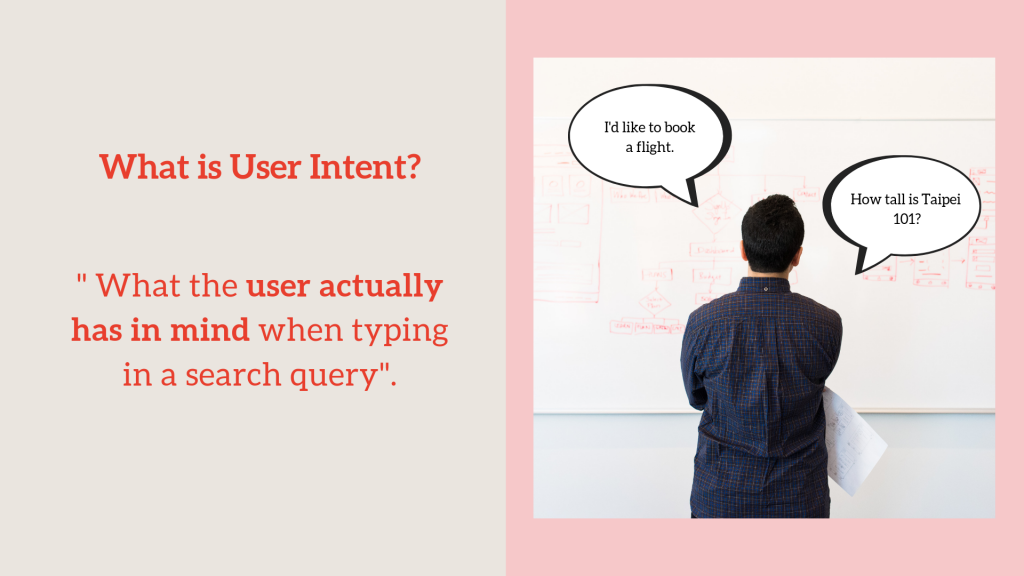
A major priority for all content creators, that is.
User intent (also known as search or keyword intent) is about what the user actually has in mind when typing in a search query. It basically refers to understanding what motivates the user.
Behind every search, there is an intention that Google, in particular, seeks to satisfy. Users of the search engine always want answers to their questions – to do something, learn something, go somewhere or purchase something. In each of these actions, they exhibit an intent.
If I enter “how to fix a leaking tap”, Google will understand I am looking for specific instructions and not a link to an online shop with pipe accessories. That is why, before implementing an intent-based SEO strategy, you should know what types of user intent are out there.
Types of User Intent
Interestingly, everyone has their own way of searching. What you need to understand is that everyone who performs an online search has a specific intent. Each stage contains users who have very different mindsets.
Let’s revisit the purpose of a search query (types of user intent) that comes in three major ways:
1. Informational
A user has informational intent when he or she wants to find some information, such as tips, instructions or news on some topic. These types of user intent have the largest search volume as it takes up more than 80% of the searches.
As a writer, you should always focus on targeting people that need to be informed and make sure you are delivering valuable information to them, hoping they would spend more time on your website and become regulars.
Search Query: How To, Tips, What Is, Instruction and other 5W1H-questions
2. Navigational
A person with navigational intent wants to find a specific website. Here, the user has no clear intent to purchase yet and simply wishes to visit a particular type of website.
With such searches, these types of user intent mean users are usually trying to reach the websites or targeted subpages of brands, businesses, and organizations. Make sure you are well-optimized for your company name (branded keywords) as it is just as important as building out your website for non-branded traffic.
Search Query: check-in for my Qantas Flight, Facebook login, five-star hotels in Taiwan
3. Transactional
These types of user intent refer to users who want to conduct some action, namely to buy or order something but they want to gather more information which can influence them to take action. Transactional queries boil down to getting consumers to convert.
Keep in mind that it doesn’t always mean money will be changing hands here. They may be ready to submit their personal information (opt-in). It is your job as a content marketer to make sure that specific search queries and calls to action lead to your website.
Search Query: Buy, Purchase, Price, Cheap, Shop
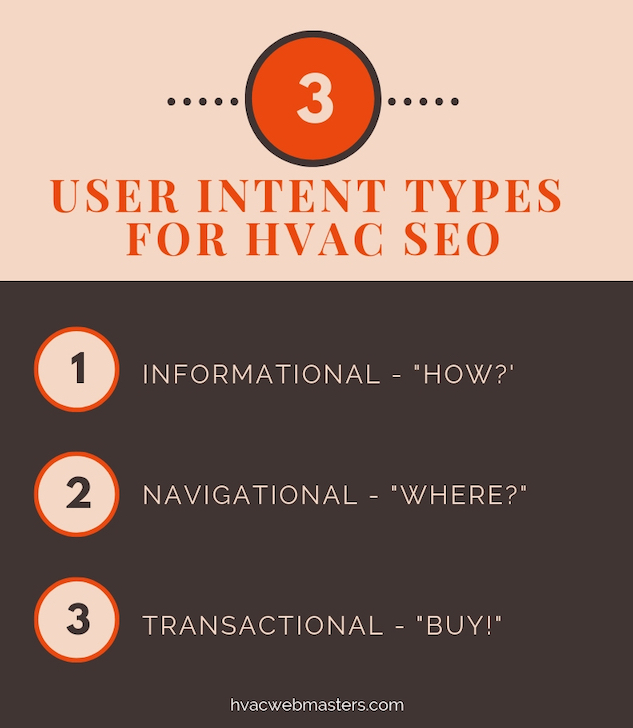
Similarly, Google, in their Google Search Quality Rater guidelines, calls these three categories as:
- Do (transactional)
- Know (informational)
- Go (navigational)
It’s important to capture traffic at each of these stages and to do this you need to have content that can cater to each of your user’s search requirements and needs.
When all of these are well thought out, you’re helping to maximize the overall performance of your website.
5 Reasons Why User Intent Is Important In SEO
Sometimes you wonder, as an SEO, does any of this really matter?
Well, yes.
If you want to rank in Google in 2019, you need to be the most relevant result for the query. First and foremost, that means creating content that aligns with the user’s intent. If you know your user intent, you will any day be ahead of the game. Simply put: satisfying search intent is ultimately Google’s #1 goal.
So if you want to succeed with SEO and content marketing today, user intent needs to be a big part of your approach.
1. Focuses On Understanding The User
Knowing what your potential customers want to find on your website plays a major factor in success. User intent tells you, as a site owner, what your audience is looking for.
It is important to note that your content should always be aligned with your business, industry, and ultimately, the products and services your company actually offers.
If you’re not aware of this, Google actually uses search intent when ranking websites in its search results. By understanding the intention of the user, Google can better serve its users by directing them to the right content.
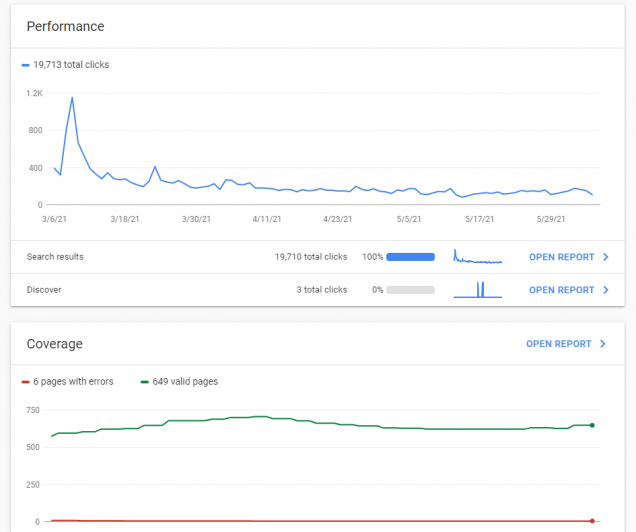
One of the best ways to learn about user intent as it relates to your particular audience and the people visiting your site is to look at analytics.
Using Google’s very own Google Search Console, investigate which keywords are being used to find your website and search for elements of user intent. Click on the name of the website you want to check, and navigate to Search Traffic > Search Analytics to see the top search queries.
In doing so, you’ll learn about what your particular audience is looking for, and identify opportunities to create and deliver the types of content and resources they really want and need.
Another tool that can give you the exact intent behind each of the keywords you retrieve is none other than BiQ’s Keyword Intelligence.
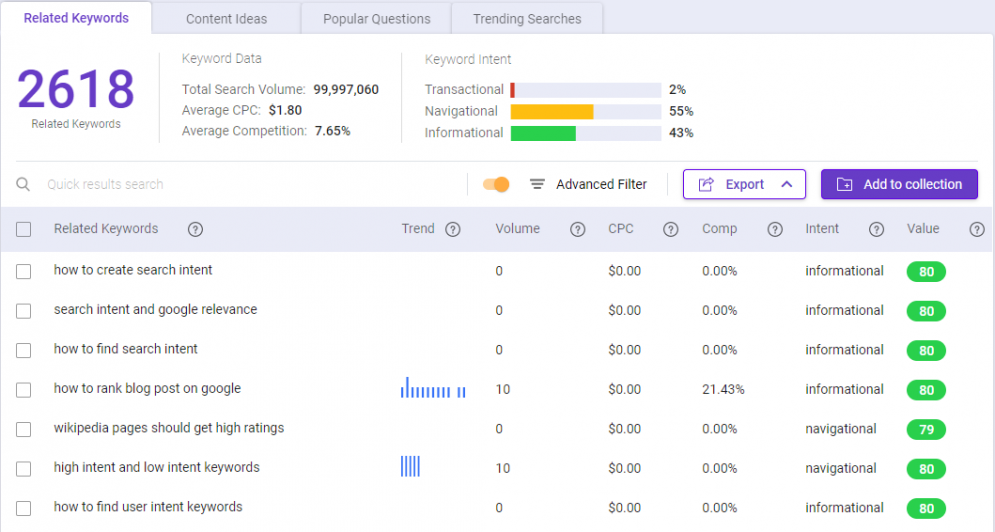
By knowing the intent behind each keyword, you’re understanding the motive someone has when conducting a search.
For example, a keyword that has transactional intent means the action you are hoping the users take such as signing up for your newsletter or visiting your restaurant.
As content marketers, we are always needing to change up how we are producing and distributing our content based not just on our audience’s demands but those of Google.
2. Improves Time On-Site
Every time we click on a link to visit a webpage, there are certain expectations set.
Not denoting clear intent can provide false expectations for users. Sometimes, companies attempt to increase organic traffic with misleading titles. The title makes it appear as though the article is relevant but the content turns out to be something completely different.
Have you ever thought about what would have happened if they click through your site and the content is not what they expected? They’ll leave the page without thinking twice and you’ll be eroding trust amongst visitors. This is clearly a non-genuine attempt to answer the user’s query.
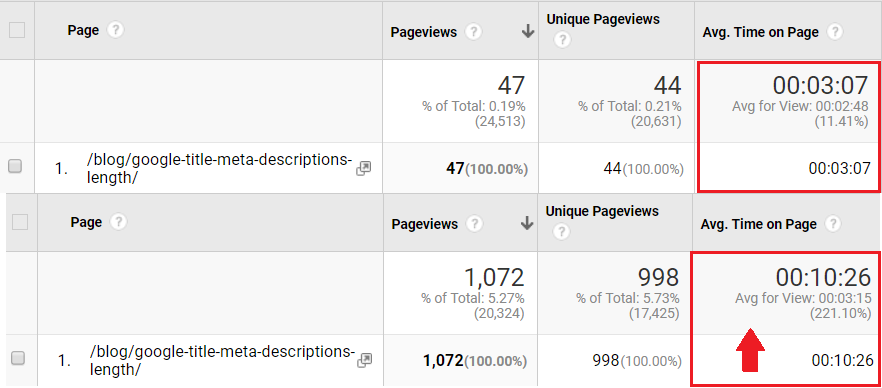
It goes without saying, drawing in disinterested users hurts your rankings due to an increased bounce rate. A good average for a time-spent metric depends on what kind of content you are offering.
If it is a long article, and your average time spent on the page is 10 seconds, then this is a huge indicator that you have a big problem. As a site owner, your goal is to make users stay long enough to see what you have to offer.
The bottom line is: If it fits what they are looking for, they’ll stay and you’ll win – which brings us to the next point.
3. Leads To More Traffic, Higher Rankings, And Conversions
Concurrently, when the time spent on the page improves, it’ll bring you positive effects on your site’s traffic, ranking, and conversion too.
Content that speaks to user intent results in a website that converts positively. Because if you concisely understand the needs and wants of your customers, you’ll start ranking higher in the SERPs and gain more traffic at the same time.
Oh, there’s also this tip that not many of us practice.
Don’t think that getting more traffic only comes from publishing new content. In fact, going back and re-optimizing old content for user intent is one of the fastest ways to get more organic traffic to your website.
For example, this post used to rank in the top 20 for the keyword “http vs https”.
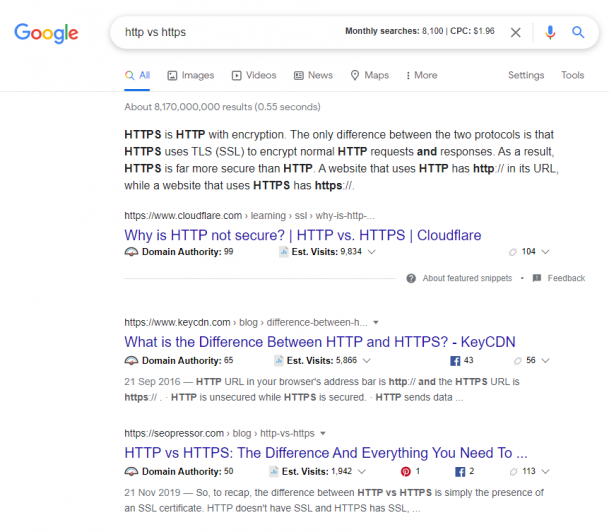
Knowing Google’s algorithm that puts more emphasis on user intent, this blog was optimized the way it should be, and guess what? This blog has been ranking on #1 spot ever since!
Once you’ve understood the intent, you can review the content that ranks and look for opportunities where you know you can improve the content that is already ranking.
Speaking from previous experiences, I’ve gotten the majority of my site traffic from Google for years. Over time, you’ll see it pay off in the long term with no further intervention. So don’t miss out on this golden opportunity!
4. Gives You Unique Keyword Suggestions
When doing keyword research, most of us would mindlessly choose “popular keywords” which limits the ability to look beyond the glaring “search volume” count.
When you shift your focus to “user intent”, you’re capturing what users are actually inputting in the search field and that means you’re putting yourself in your user’s shoes.
As seen on BiQ’s Keyword Intelligence, it’s not a challenge to figure out that “How to change a tire” is a very popular keyword. That’s where the average SEO professionals end their search for target keywords.

But what about the user who wants to figure out how to get change a tire without any help from service providers? Or only by using limited tools found in your car? Then this user might search for “how to change a tire without a complete set of tools”.
How’s that for user intent? Knowing this, your article could even have that exact title and would probably yield a very high conversion rate, especially if you are able to provide valuable, actionable advice that fits this criterion.
*** On a side note, if you wish to check the important metrics (related keywords, search volume, CPC, and Competition right from your browser, head over to LiveKeyword! It’s a free browser extension guaranteed to save your time and make keyword research a breeze for you.
5. Generates Better Overall Content Strategies
If you know your answer to a given question is the best and most useful answer out there, then the remainder of the SEO process becomes far easier.
Relevancy, high quality, and original content have always been a pillar for successful SEO strategies. Making the effort to understand the importance of each of those criteria can simplify the entire SEO process.
To draft compelling and relevant content that is targeted to your audience, use BiQ Content Intelligence. For any keyword of the document created, the tool analyzes it with the top-performing organic content on Google.
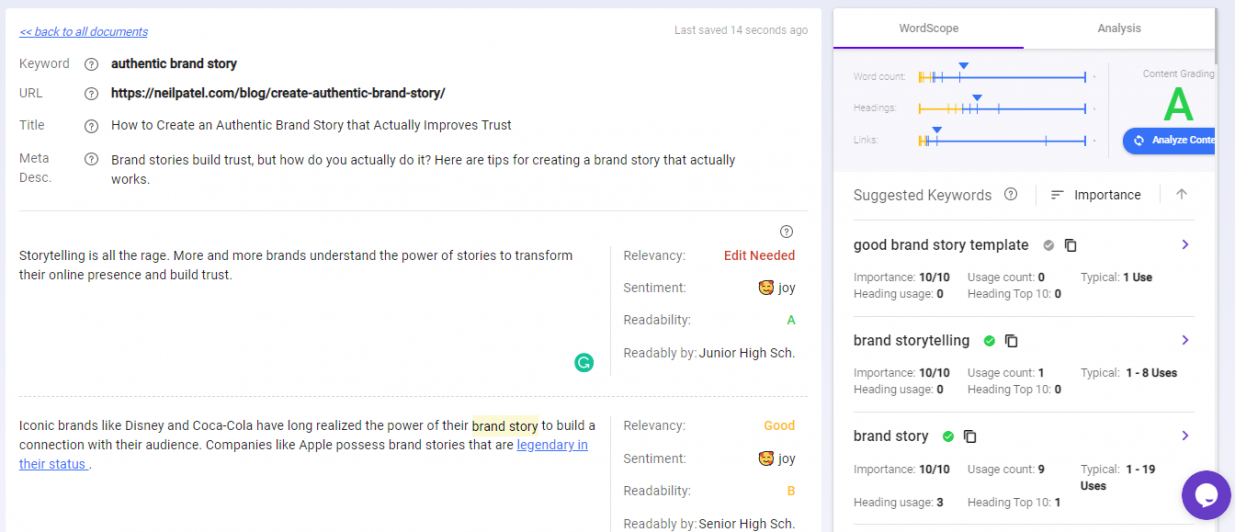
Better still, it gives you a breakdown of your keyword in terms of usage, similar keywords, and example sentences.
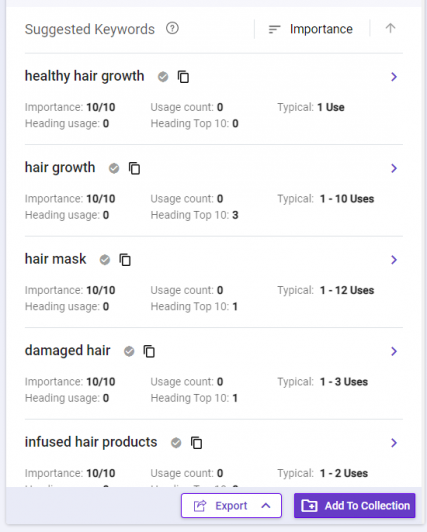
Once you’ve finished drafting your blog, hit the analyze button. One of the specialties of Content Intelligence lies in the paragraph-by-paragraph analysis. The analysis is divided into sections, and you can see their relevancy, sentiment, and readability.

They’re a lifesaver if you want a quick insight into how your content is performing. It will unveil all critical SEO errors in your content.
Content that is based on user intent is much more focused and therefore, more impactful. By searching for terms you want to target and reviewing what content ranks well, you can identify what type of content you should be creating.
5 Steps To Optimize Content For User Intent
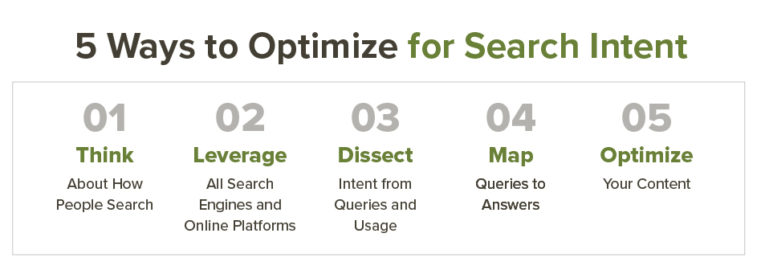
User intent should dictate the type of content you create. If the keyword has informational intent, write a blog post. If it has transactional intent, create a product page, you get it right?
Back to the question, how do you make sure you’re optimizing for user intent? Well, as with all things SEO-related, there’s no special trick, but there are two overachieving goals to keep in mind:
- Create high quality, useful content
- Make sure your site is easy to use and navigate
With these two goals applied along with your SEO efforts, the specific actions you take to achieve them will depend on the type of user intent you’re trying to appeal to.
Now, to properly optimize content for search intent, there are five key steps that you should be taking:
1. Find Out Potential Existing Pages
You should have identified your potential content, and if you haven’t already, it’s time to match it to intent. Find your top-performing content as this will be easier to match the user intent, locate them, and are proven to be engaging.
2. Probe Intent
The question to answer here is why someone does search and specifically land on your page? Right before landing on your page, what were they searching for? What are the answers they expect to get from your page? You need to understand the intent to know what you’ve done right and on what you’ll need to improve.
3. Go Forth and Optimize
After pointing out your weak points, optimize! Build trust and descriptive information to support your claims, and your keyword will naturally fall in place. Don’t forget to optimize the meta description and title tags on your pages as well.
However, do not try too hard to prove to search engines that you are relevant, instead, focus on your readers and the experience you have of them with your content.
4. Publish the Changes
Double-check and make sure that you’ve got everything in order. Then it’s time to publish your content and also establish your benchmark for statistics.
Mark the point you are at the moment of your publishing to be able to get an idea of the impact your intent optimization will have. You’ll be surprised as was I!
5. Record, Measure & Analyze Result
After a short while of your content running on the internet, monitor your analytics. Analyze what worked and what didn’t, then make the necessary adjustments and publish the content once more if needed.
For instance, knowing the amount of time people spend on your page can be a good indicator of how well you meet the needs of the searcher.
Conclusion
After an entire blog post on the importance of user intent, I hope you’ve understood that excelling in user intent is critical to be successful in SEO. What’s more, it is perhaps the most important “ranking factor” in 2019.
Of course, cracking the user intent is no easy feat. You’ll need to arm yourself with ample patience, intent research, and practice to see the magic.
Fail to give users what they want, and your chances of getting traffic and higher rankings are slim to none. From now on, make it a mission to give users what they desire.
You’ll see yourself going very far down the road, trust me.
Do you agree with the points above mentioning why user intent is important in SEO? If you have any queries and additional information to share, please do so in the comments section below! I’ll be more than happy to discuss further on this topic with all of you.




